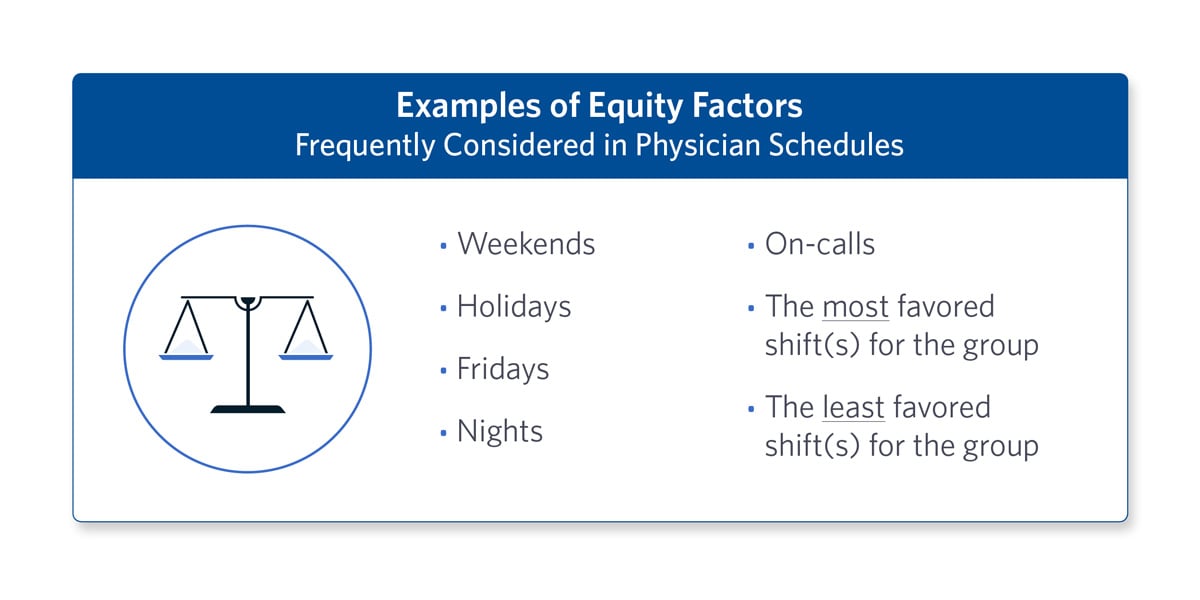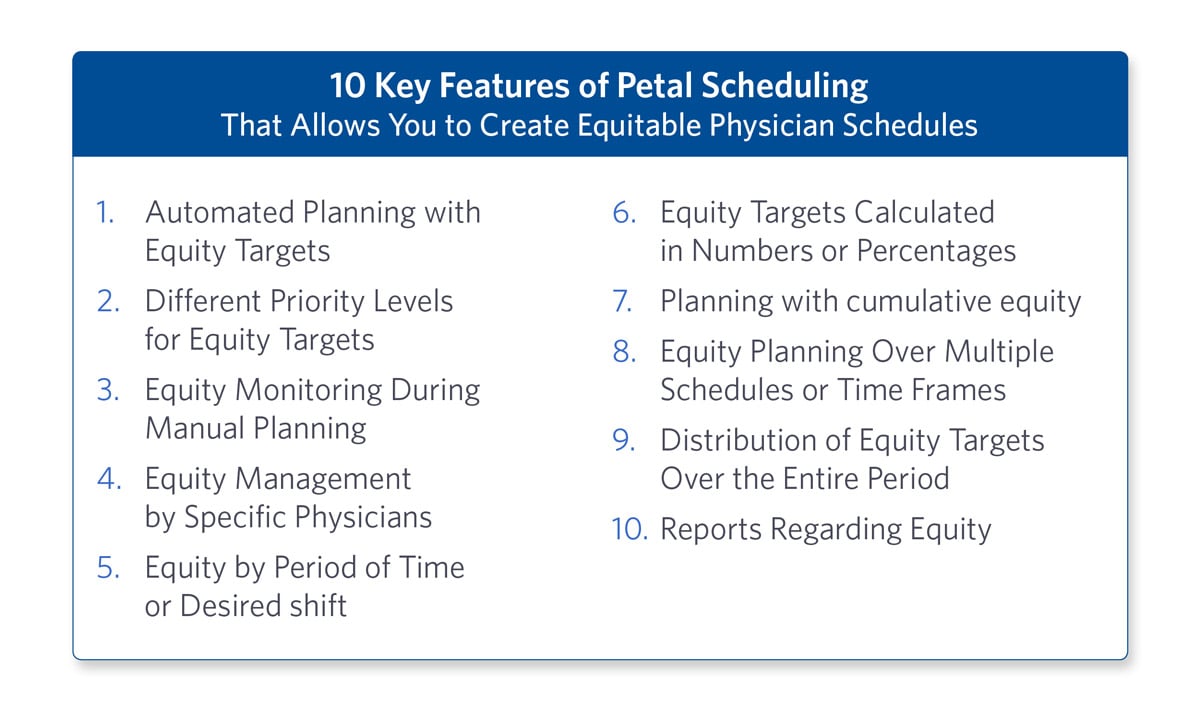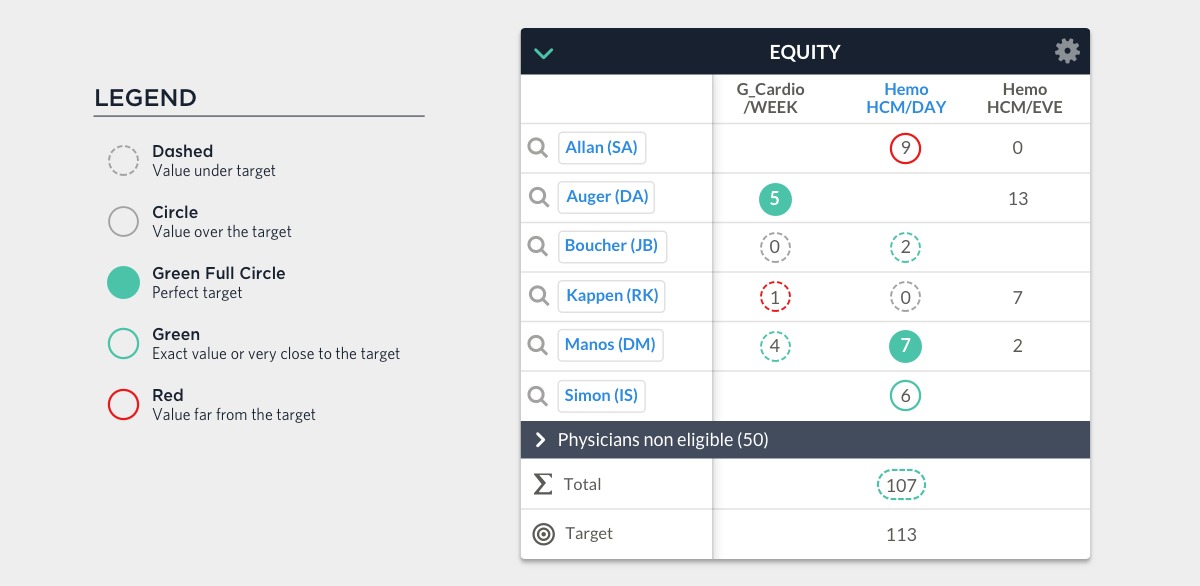
Since each medical team is unique, there is no universal recipe for creating a schedule for physicians which distributes shifts fairly. However, after having coached more than 2,500 schedulers to create and manage physician schedules, the PetalMD team knows each group of physicians can find their own equity recipe by following these steps.
Step 1: Set Equity Targets For Your Physician Group
1. Select the Equity Factors for Which the Physician Group Wishes a Fair Distribution
Equity factors refer to the shifts that physicians want to be equitably distributed within their group. They can correspond to time frames within a week (e.g. weekends, nights, or Fridays) or to certain types of tasks (e.g. on-call shifts, operations, medical exams). Most of the time, equity factors will apply to the least or most desired shifts.

2. Set Equity Targets for Each of the Equity Factors
The equity targets correspond to the desired distribution of specific shifts, more precisely: equity factors. For example, if weekends have been identified as an equity factor, the equity target could be "every physician must work at least two weekends over a period of 3 months". Equity targets should be decided with the participation of every physician, then taken into consideration during the schedule planning process.
3. Identify Exceptions to Equity Targets
The scheduler must often consider exceptions when incorporating equity targets into the schedule planning. For it to be equitable, some physicians or teams of physicians should not be given the same equity targets as others. For example, because of special circumstances, such as a contract with a hospital or a part-time job, one of the team members might require an exception to the equity rule(s). It is important to identify these exceptions and assign equity targets accordingly (e.g. Dr. A is the only one who always wants to work during weekends).
See also :

Step 2: Implement Equity Targets in Your Schedule Planning Process
To efficiently implement equity in the creation process for schedules, we recommended using a specialized solution. Indeed, creating the schedule manually and with tools that are not adapted to the reality of physicians’ practices requires a lot of time. In addition, it is easy to miss the equity targets established for large groups, because of the large number of factors. The more physicians there are in the group, and the more equity factors there are to consider, and the more it is relevant to use a planning tool that automatically addresses equity issues.
For example, here are 10 key features of Petal Scheduling, the physician scheduling tool developed by PetalMD, that allows you to set up fairness factors to create equitable physician schedules.
1. Automated Planning with Equity Targets
The solution developed by PetalMD can transform the different fairness goals and exceptions identified by the physicians into mathematical algorithms that will allow a fair schedule to be created automatically. Since physicians’ schedules are usually complex, fairness is only one of the many factors that are likely to be considered in automated planning.
2. Different Priority Levels for Equity Targets
The objectives concerning equity that automated planning systems should take into account can be configured according to two priority levels: limiting or influential.
Limiting: The equity targets must be respected, for example, when a shift involves a contract with a hospital. Specifically, this priority level prevents automated planning from exceeding equity targets when fulfilling all the shift assignments.
Influent: The equity targets are an ideal to strive to achieve, but can be ignored under certain circumstances. Specifically, this priority level influences assignments without preventing automated planning from exceeding targets to fill all assignments.
3. Equity Monitoring During Manual Planning
Schedulers who are not taking advantage of automated planning – an exclusive feature of Petal Scheduling's Advanced Plan – still have access to a "fairness meter". When the scheduler sets a fairness goal, for example 4 on-call shifts per physician for a period of 3 months, the meter will indicate whether the target has been obtained or exceeded for each physician or team of physicians. This meter allows the scheduler to adjust the shift distributions during the planning phase.

4. Equity Management by Specific Physicians
To take into account various exceptions, the scheduler can set different equity targets for each physicians. For example, this feature allows the scheduler to set specific targets for part-time physicians, or for physicians who are not qualified to do a specific shift type.
5. Equity by Period of Time or Desired shifts
The scheduler can set up an equity target for holidays, nights, weekends, or any other period of time, for example, Fridays. In addition to designated time periods, the equity meter can also be configured for a particular task or shift type, for example an on-call shift, or a specific type of operation.
6. Equity Targets Calculated in Numbers or Percentages
The software can be used to determine how many shifts should be assigned to each physician in two ways: in absolute numbers or as a percentage. For example, the scheduler may want to assign 10 on-call shifts per physician over a 6-month period, or 25% of the full-time on-call shift coverage to part-time physicians.
7. Planning With Cumulative Equity
From one scheduled period to another, the number of holidays is not necessarily the same, which can be a challenge in terms of fair shift distribution. To ensure longer-term equitable shift distribution, for example over a year, the scheduler can import the fairness data from one or more previous schedule(s).
8. Equity Planning Over Multiple Schedules or Time Frames
Shift trades may occur between physicians during the scheduled period and alter the initial planning. The planner can therefore import equity values as they were when the schedule was published, or as they are now.

9. Distribution of Equity Targets Over the Entire Period
If the equity target of a specific physician is set at 18 night shifts over a period of 3 months, how can a scheduler make sure that the physician won’t be assigned 12 night shifts during first month, but only 3 night shifts during the second and third months? The tool developed by PetalMD allows you to configure equity goals for specific time periods within the global equity goal of the schedule. Back to the example of an equity target set to 18 night shifts over a period of 3 months: this feature would allow the scheduler to target 6 night shifts per month, so that the shifts are distribute more evenly over the scheduled period.
10. Reports Regarding Equity
To make sure that they created a fair schedule, the scheduler can obtain a summary file that shows how many shifts were assigned to each physician when the schedule was published. In addition to providing analysis for audit purposes, this report can help the scheduler in creating the next schedule while taking into account the equity target achievements of the last schedule.
Give Your Physicians Team a Schedule that is Equitable
Are you a physician and, if so, would you like to use a modern and effective tool to create and manage your team's schedules? Request a custom demo of Petal Scheduling to see how the solution can adapt to the reality of your medical service.

